Digital artworks - 2021 to the present days
2021 - The Marechaux Boulevard, tramway line T3a - Digital photomontage
2021 - The last light - Black token, digital drawing
2021 - Paris, Rivoli street during the containment - Digital painting
2021 - Pont Neuf, nocturnal view - Digital painting
2021 - Paris, rue de l'Arbre Sec during the containment - Digital watercolour
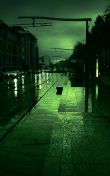
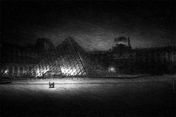
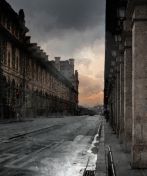
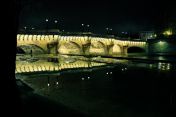
2021 - The Liberty of Grenelle - Digital painting
These artworks are specificaly intended to be turned into NFT, joining that way the first wave of NFT artists, succeeding the forerunners of the years 2017-2020.
This first wave of NFT artists started with the record reached by the artist Beeple on March 11, 2021. At this time, it popularized the NFTs to the general public and the artists.
The first NFT from Luc Dartois is called "The Liberty of Grenelle", it has been minted on June 11th, 2021. Dartois' NFTs can be found on exchange platforms such as: TryShowtime, Rarible, Portion, Foundation. Some of them are represented by the label HXMX Signature on the Satoshi.ART platform.
~

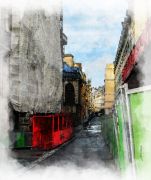
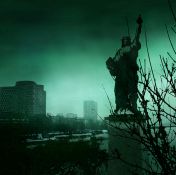
The production of digital artwork started during the year 2021.
Frequently started on the basis of an already existing photography, they are worked much more freely to become far different from the original picture.
Theyr final aspect can be as various as paintings, watercolours, drawings (also called "Black token" because of the predominance of black and nocturnal atmosphere), photomontages... the difference being that each time, the work is entirely done on computer.
The majority of these artworks are in colour, contrary to the recent physical paintings which are mostly in black and white.
The production is much more prolific then the physical paintings. Around 200 artworks have been done in one month and a half.
~
~
~
~
~
~
~
~
After completion, canvases are not varnished, but are systematically framed under anti-reflective glass. However, there have been cases where glass has been took out for late retouchings.
These paintings gather a wide variety of different techniques, which make them impossible to be replicated identically. Fake that can't be distinguished from the original can not exist.
Matter can be sculpted, engraved, assembled, sticked, mixed, projected, combined... In one painting there is at least as much, and even more different techniques then different matters.
This explain why this kind of artwork is of very great rarity.
2011 - The Banks
These volumes can also involve the outside light by mixing it with the inner light of the pigments.
Vision is getting organized between the void and the filled through matters masses.
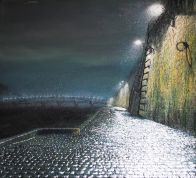
2018-2019 - Nowhere
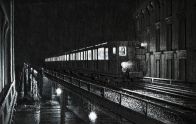
2016-2017 - Paris, Eastern Railway Station
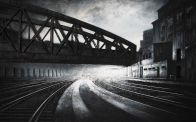
2017
2014
2010
1997
1996
1994



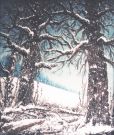

1992


Evolution of style from the beginning to the present days.
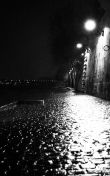
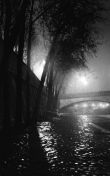
Comeback in paintings were simultaneous to the starting of photography. If photography was already practised since the 1990s, it was more for an utilitarian function at this time.
Starting from 2008, photography is taking place in a wider reflection about framing, composition, and especially lighting. That's how few photos directly resulted in some paintings.
Subjects are coming mainly from the parisian surroudings, processed in nocturnal light or rainy atmosphere. Images are worked in black and white. Once again, human presence is almost non-existant.
Lighting is influenced by protographers of the 1930s: Georges Brassaï, Bill Brandt, Nicolas Yantchevsky, ... but also by actual photographers: Simon Marsden (whose one of his work inspired a painting), Michael Kenna, Michael Schlegel...
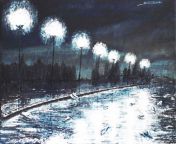
This will lead to the concept of the “Merging of the two worlds”: a painting should say as much about the inner state of its author as about the outside world that is surrounding the author. Therefore, with a single light effect, it can be said much more about the world and its time then in a History book.
Three stakeholders are involved in a canvas construction: the eye, the hand (the third eye of the painter), the brain. This trinity finds its counterpart in the fundamentals of world's perception: space, time, and the invisible world (where the spirit stands). The eye perceives space, the brain were the memory is stored perceives time, the hand transmits spirit.
An idea which is not embodied is a sterile idea. The duty of the artist is to solidify the thinking into the matter without loosing the vitality of thought.
In other words, the incarnation of the idea counts as much as the idea itself. If the incarnation is weak, then the idea too will be weak... and vice versa.
So a painting is not aimed to slavishly mimic Creation. A painting should be itself Creation.
2015 - The Stones
2011-2014 - The Cathedral
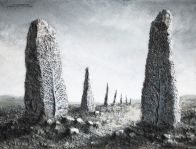
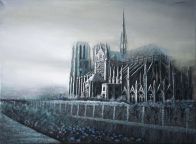
Exhibitions resume from the year 2011 onwards: Art en Capital at the Grand-Palais in Paris, then Mona Lisa gallery and Thuillier gallery respectively in 2012 and early 2016.
Starting from the end of 2016, the first exhibitions abroad are taking place in the United States: Miami, New York, then Las Vegas.
In the same time, composition tend to a sleeker style while being more structured. It's about combining matters volume with two-dimensional perspective lines.
The comeback in paintings started firstly by completing some unfinished canvases, or by retouching some existing paintings in order to resharpen the skills. These paintings are making the switch between the end of the second period and the beginning of the third period.


Third period - 2009 to the present days
The 2000-2009 interruption
1997 - The Street
1995 - The Threshold
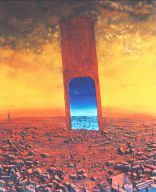
The particular colour chart of this brand is offset from a classical range of pigments. For exemple there is no primary colour.
These paints are constantly used since the beginning to the present days. Only one exception: a canvas painted in acrylics in 1993, which track have been lost.
In 1996, an awarded canvas from the Saint-Maur des Fossés graphic arts biennial, hosted by the Villa Medicis, is acquired by the Saint-Maur des Fossés museum.
Universe of the begining, influenced by artworks such as those of Z. Beksinski, will progressively change.
From 1997-98, artworks inspired by immediate surroundings of Paris began to appear. It's also at this moment that matters techniques started to gain in complexity. More then one year and half will be necessary to complete the Saint-Jacques Tower, sculpted and engraved in cement. Some ruins scattered around the tower show that the symbolist part is still existing, but in a more discrete manner.
Second period - 1995-1999
1994 - Blind Messenger
First period - 1991-1994
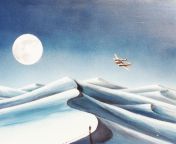
The fineness of the pigments does not enable heavy impasto nor dense shades of paint. The need to find other ways of getting more thickness has led to the use of matters. First as a loading, then as a stand-alone component separated from the pigment from 1995 onwards.
Paintings from the beginnings (1991-1994) are almost all made exclusively with this kind of pigments. But attempts to load the pigments mainly with plaster were conducted already in 1993.
These are also the only canvases some of which have been coloured with the use of an airbrush.
The various themes of the beginings are also accorded at the discretion of the particular orders of this period, including an order for an album cover.
Only few paintings of this period have succeeded in reaching us. Barely around a dozen of them are estimated to be left.
Firstly limited, human presence disappears completly from 1995 onwards. This absence can be felt even more intensively in the parisian scenes of the 2010s. Time is getting suspended.
Only the viewer is present in a world which has become different, where he is placed in front of his own vestiges.
These paintings portray a world that doesn't believe in his future, whose system announce its own bankruptcy while waiting for the end.
Canvases from this period have a very long gestation and construction duration, five to seven month per canvas in average. While several painters are creating entire series in order to approach a thematic in all its facets, one painting focus on its own a complete synthesis of a thematic.
Canvases are worked, inspected, evaluated on a continuous basis during the whole construction process, and reworked until the result is getting satisfactory. Therefore, some canvases can be reworked and completed more then twenty years after theyr beginning.
Starting from 2014-15, colours tend to fade away and the first black and white paintings are emerging. Colour is giving way to light and texture's vibrations but doesn't disapear entirely. Some paintings in colour will still be made occasionally.
The de-saturation of the colours announce the black and white canvases to come.
Viewed from a distance, these canvases are reminding photographies. From a closer look, we realize that they are paintings. And from an even closer look, matters volume appear and emerge from the canvas.
In the mid 2010s a reflection is developing about matters, firstly by trying to convert the rules of simultaneous contrasts of the colours to light and matters, secondly by taking inspiration of W. Kandinsky's writings (Concerning the spiritual in art, Point and line to plan) in order to transfer Kandinsky's reflections about colours and theyr symbolism to the matters.
Matter allow to avoid the Malevitch pitfall, for whom the search for truth requires removal and rejection of any other reality then the artwork's self-reality. To the supreme completion of non-objectivity, matter oppose its absolute presence. The outside world is real, weather we like it or not. By the choice of figuration, the soul claims its enchoring into the real world.
The third contribution related to reflections is coming from the Treatise on the Philosophy of Painting (Oneness of brush strokes) of the monk Zhu-Ruoji, aka Chi-Tao (1642-1707).
Starting from 1995 is the beginning of the second period of paintings: since this year every canvas will be made with matters. Starting with a partial covering of the surface, matters will progressively coat the whole area of the canvases as the years go by.
That does not mean that pigment disappear. Its role evolve to become a matter among others.
Starting from this moment, exhibition will be also held on a more regular basis. Mainly in Paris but also in the regions (Les Issambres, Nantes, Les Arcs-sur-Argens, Le Puy-en-Velay, Bordeaux)
Luc Dartois painted his first canvas (3m x 1,80m) in 1991 during his business school studies. He started his first exhibitions one year later.
Right the first canvas, Humbrol enamel glycerophtalic paints have been used. These paints are very resistant to light and are made of very thin pigments (one coat is around 76 microns thick).
1991 - The Wall
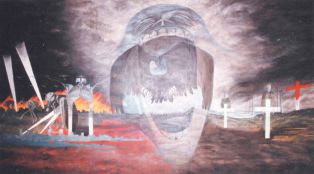
In 2001 the Dallay publishing company is created by Luc Dartois and Jean-Bernard Pillet: a publishing house of postage stamp valuation catalogues including stamps issued by France, Monaco, Andorra, Former colonies, Overseas territories and French occupation zones.
All activities of creation, page layout, valuation updating, marketing, delivery, communication, management, administration, ... being carried out by two persons, a full-time availability were required. During this period, paintings production and exhibitions have been suspended.
However, the creation of postage stamps for New Caledonia and Polynesia with layout signed by Luc Dartois can be noted.
Luc will also meet one of his first collectors within the framework of his activity as publisher. Around fifteen canvases will be acquired, which still represent to this day the biggest collection of Luc Dartois' paintings in private hands.
At the present day, no one knows what has become this collection.
In 2008, the Dallay company is merged with the Maury society, then sold in 2009.
Luc is born Paris in 1970.
He shows an early interest for drawing and model making, and become soon well-experienced in these disciplines.
Fr
Eng
Paintings and matters on canvas
Luc Dartois

Pictures, texts, videos, illustration and logos contained on this website are exclusive property of Luc Dartois.
Any other use then strictly private use, any public distribution without author's permission iis prohibited.
Copyright © Luc Dartois